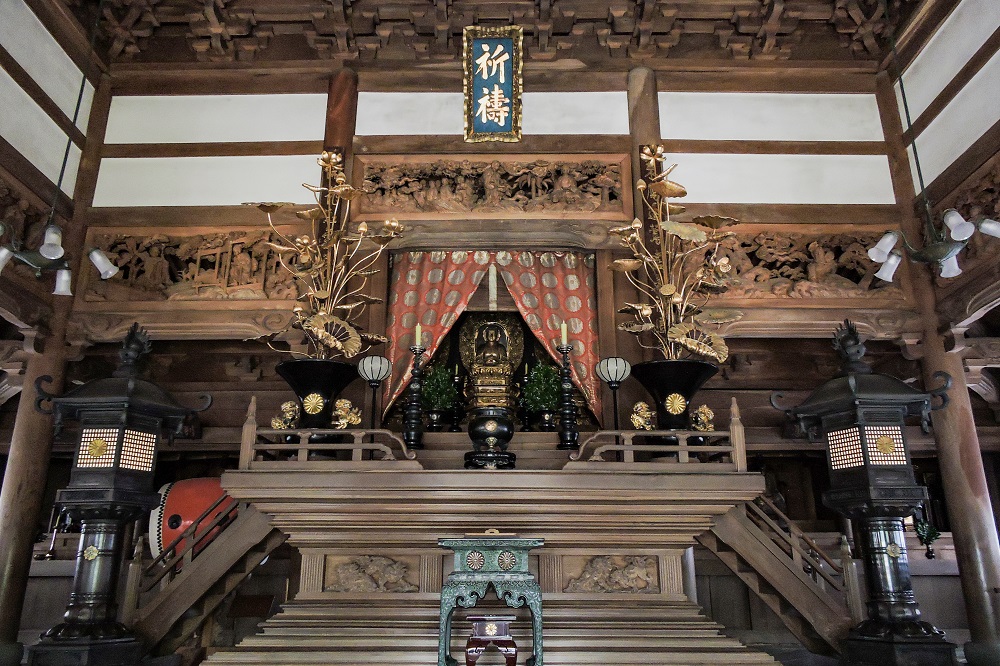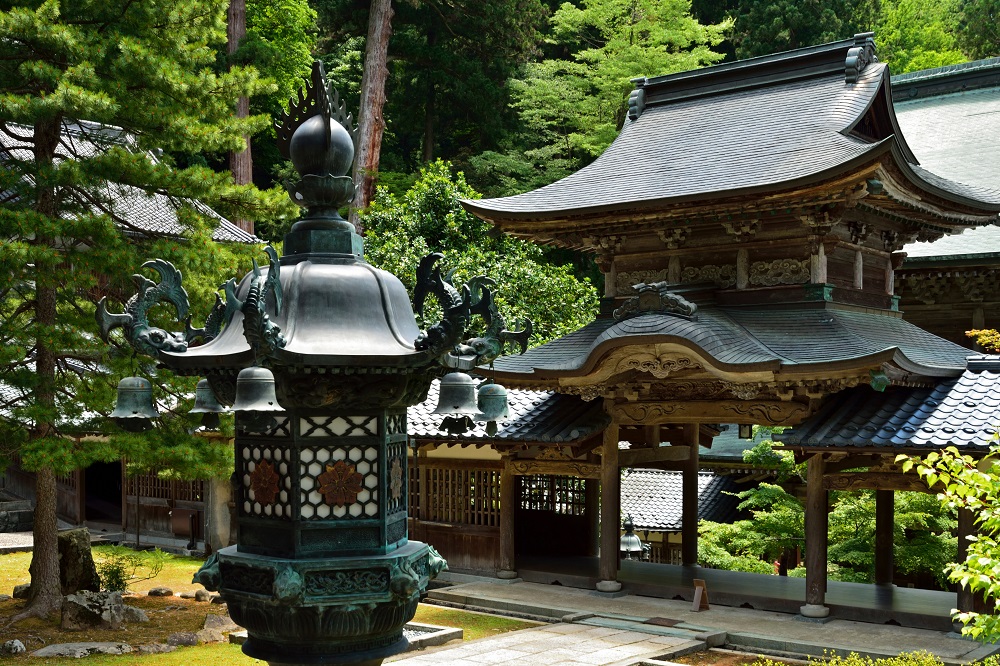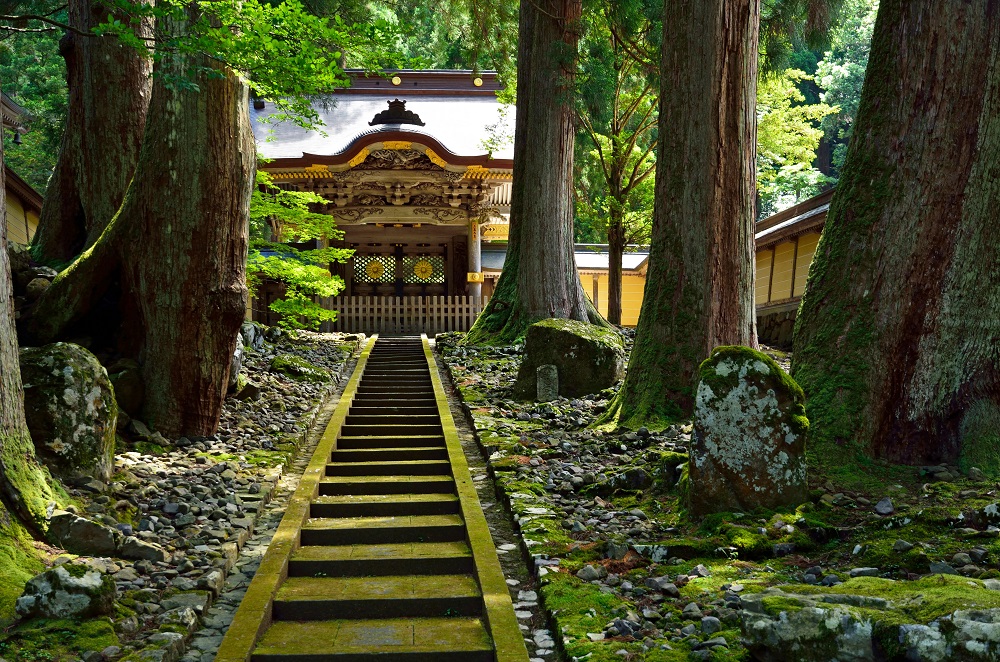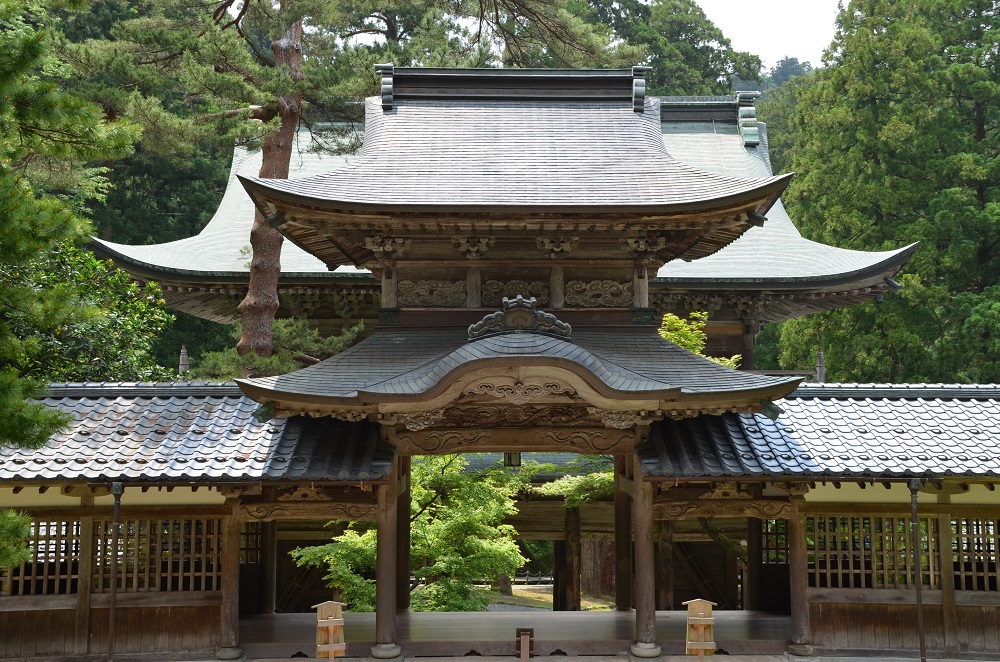Eiheiji Temple, founded in 1244 by Zen Master Dogen, is a Zen training center and the head temple of the Soto sect of Buddhism in Japan. Located deep in the mountains in a verdant natural setting, the grounds of Eiheiji Temple encompass more than 70 halls and towers. Among them, the seven halls, or the “Shichido Garan,” namely: “Sanmon, Butsuden, Hatto, Sodo, Kuin, Yokushitsu, and Tosu” are considered especially important buildings. At Eiheiji Temple, many monks still practice Zen according to the strict rules of etiquette prescribed by Zen Master Dogen.

Dogen Zenji, the founder of Eiheiji Temple, was born in Kyoto in 1200. At the age of 14, he attained enlightenment on Mt. Hiei, and at the age of 24, he traveled to China during the Song dynasty (960-1279) with the monk Myozen (a disciple of Zen Master Eisai, who had studied Zen teachings in the Song dynasty before Zen Master Dogen) to pursue the path of Buddhism. While touring the temples of the Song Dynasty, Zen Master Dogen met Zen Master Nyojo, who became his regular teacher. After returning to Japan at the age of 28, he wrote "Fukan Zazengi" to transmit the correct zazen method and teachings. At the age of 34, he built Kosho-ji Temple in Fukakusa, Kyoto, and began training practitioners and teaching others. Later, at the age of 45, he was invited by Hatano Yoshishige to Echizen, where he built Daibutsuji Temple (renamed "Eiheiji Temple" two years later) and continued the teaching and training of his students. The Shobogenzo, which he continued to write until his death in 1253 at the age of 54, has become a scripture of the Soto sect.

Among the many historic buildings within the precincts of Eiheiji Temple, seven halls: the Sanmon (gate), Butsuden (Buddha hall), Hodo (lecture hall), Sodo (preists’ hall), Kuin (office/kitchen), Yokushitsu (bathhouse), and Tosu (toilet) are known as "Shichido Garan" and are considered especially important as austere places where monks practice their asceticism.
The Sanmon Gate, rebuilt in 1749, is the oldest building in Eiheiji Temple. It is the entrance to the temple, and the Four Heavenly Kings, the guardian deities of Buddhism, are enshrined on the sides of the building.
The “Butsuden” is the central building of the “Shichido Garan.” It is a beautiful building with a double roof in the Chinese Song style and a cobblestone floor, and you can admire sculptures wrought in the Zen Buddhist style.
The “Hodo” corresponds to the main hall of a regular temple and is the place where morning lessons and memorial services are held. The main deity, “Sho-Kannon Bosatsu” is enshrined in the center. It is the highest of the seven temple complexes and offers beautiful views.
The “Sodo” is the place for monks to practice Zen meditation, eat, and sleep, while the “Kuin,” “Yokushitsu,” and “Tosu” are the kitchen, bathroom, and lavatory, respectively.

At Eiheiji Temple, many monks are still practicing daily. Among the daily disciplines practiced by Eiheiji monks, zazen, the primary Zen meditation practice, morning chanting performed daily for a year, and sutra copying can be undertaken by visitors, allowing them to strengthen their minds and bodies by performing the practices of Eiheiji monks in the very place where they dedicate their lives to daily devotions at the temple. Eiheiji Temple also has a lodging house where visitors can experience a full day of ascetic training and taste authentic Buddhist vegetarian cuisine. There is also a training plan for foreigners, and English interpretation is available.
*At present, due to CIVID-19, lodging and training experiences have been suspended. For the latest updates, please check the official Eiheiji Temple website.
■From JR Nagoya Station, take the Hokuriku Line “Limited Express Shirasagi” to Fukui Station, and transfer to the Echizen Railway Katsuyama Eiheiji Line to Eiheiji-guchi Station.
■From JR Nagoya Station, take the Tokaido Shinkansen to Maibara Station, transfer to the “Limited Express Shirasagi” at Maibara Station to Fukui Station, and transfer to the Echizen Railway Katsuyama Eiheiji Line to Eiheiji-guchi Station.
■From JR Tokyo Station, take the Tokaido Shinkansen to Maibara, transfer at Maibara Station to the “Limited Express Shirasagi” to Fukui Station, and transfer to the Echizen Railway Katsuyama Eiheiji Line to Eiheiji-guchi Station.
■Take the Keifuku Bus Limited Express Eiheiji Liner from the east exit of Fukui Station to Eiheiji Temple (about 30 minutes).
■From Eiheiji-guchi Station, take the Keifuku Bus to Eiheiji Temple.
The “Karamon gate,” rebuilt in 1839, stands quietly in a grove of old cedar trees. Also called the “Imperial Envoy Gate,” it is a special entrance that is only opened when an envoy from the Imperial Household visits or when the head priest of Eiheiji is on his way to the temple. Its beautiful facade is worth seeing.

Zazen, the basic ascetic method of Zen, purifies the mind by correcting the posture as you are breathing quietly and looking inside yourself with a calm mind. Zazen as performed at Eiheiji Temple, the head temple of the Soto sect of Zen Buddhism, is different from what you might experience elsewhere.

The Sanmon gate is the oldest existing structure at Eiheiji Temple, built in 1749. A plaque in the upper center reads "First Soto Dojo of Japan," proclaiming its prestigious status. Four Heavenly Kings are enshrined, two on each side of the temple gate, said to guard against evil spirits from the outside. This is the gate through which trainee monks are formally admitted to Eiheiji Temple, where the determination of the prospective acolytes’ desire is tested, as it is written that only those with a will strong enough to endure the rigorous training are allowed to pass through the gate.

The ceiling paintings in Eiheiji Temple's Sanshokaku (reception hall) are not to be missed. The 156-tatami-mat hall (room measurements in Japan often use this standard, one mat being roughly 1m by 2m) is also known as the "Great Hall of Ceiling Paintings," with 230 paintings of flowers and birds on high. The lofty masterpieces are the work of 144 famous painters, and no visitor to Eiheiji should leave without seeing them. The Sanshokaku is such an essential part of the Eiheiji Temple experience that many people strain their necks gazing upon it.
43-26 Funatsu, Awara, Fukui
Founded in 1963, Grandia Housen is a large Japanese-style inn, or “ryokan,” spread over an expansive area of 7,000 tsubo (approximately 1,000 square meters). In addition to the large bathhouse Tenjo SPA, which was reopened in 2017, it houses a large ....